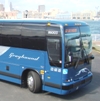
Motorcoach Industry Evaluating DOT's Action Plan
The plan lists numerous rules and research to be done during the next two years, including rules requiring seat belts and on-board electronic recording devices on motorcoach buses and limits on drivers' cell phone and PDA use.
For thousands of Americans, Thanksgiving holiday travel involves one or more bus trips. Greyhound's buses transported more than 400,000 passengers during the week of Thanksgiving in 2008, said Timothy Stokes, media relations manager for Cincinnati-based Greyhound Lines Inc.
As this holiday season approached, the company and the rest of the industry were evaluating the U.S. Department of Transportation's Motorcoach Safety Action Plan, a 56-page document released Nov. 16 that contains numerous rulemaking and research efforts to be undertaken during the next two years, including a rule requiring seat belts on motorcoach buses to be issued in the first quarter of 2010, a rule limiting drivers' cell phone and PDA use, a rule requiring on-board electronic recording devices to track hours of service and thus attempt to deal with drivers' fatigue, a new rule on tire performance, roof crush performance requirements, and implementing a driver safety history pre-employment screening program.
"Greyhound works closely with industry associations and federal agencies and values their recommendations. Our company is reviewing the initial information that was released by the Department of Transportation November 16," Stokes said Nov. 20. "Greyhound recently introduced 102 new buses in the Northeast, which include many amenities such as three-point safety harnesses with shoulder-height adjustment. We continually focus on improving our processes and equipment to ensure the safety and security of our passengers."
The American Bus Association's president and CEO, Peter J. Pantuso, welcomed the plan and said all parties should cooperate on science-based improvements that will accomplish the plan's timeline and aims. ABA's most recent census of the industry, covering 2007, says two-thirds of the passengers traveling on motorcoaches that year were students and senior citizens.
The plan shows how two DOT agencies, the Federal Motor Carrier Safety Administration and the National Highway Traffic Safety Administration, will lead this campaign. There are about 3,900 motorcoach companies operating nearly 34,000 vehicles that carry 750 million passengers per year, moving them a total of 65 billion miles annually with a high level of safety, according to the plan. But it includes a chart that shows 2004, 2005, and 2008 were three of the highest five years in terms of motorcoach passenger and driver fatalities during 1991-2008. Driver fatigue was a root cause in 37 percent of the 16 fatal motorcoach crashes investigated by NTSB between June 1998 and January 2008; other root causes in those crashes included vehicle condition (13 percent), road conditions (6 percent), inattention (13 percent) and recognition/not driver's fault (19 percent), the plan states. Ejection from the bus during a rollover was involved in the highest percentage of passenger fatalities.
The plan takes aim at the root causes by attempting to address drivers' health, drug and alcohol use, distractions, and inattention. It says outreach and enforcement activities emphasizing drivers' behavior will both be increased.
"We are committed to making sure that bus travelers reach their destinations safely," Transportation Secretary Ray LaHood said. "These improvements will not only help reduce the number of motorcoach crashes; [they] will also help save lives and reduce injuries."
Stokes said Greyhound Lines has no estimate of how many people will travel on its buses this week because many passengers buy their tickets the same day they travel.